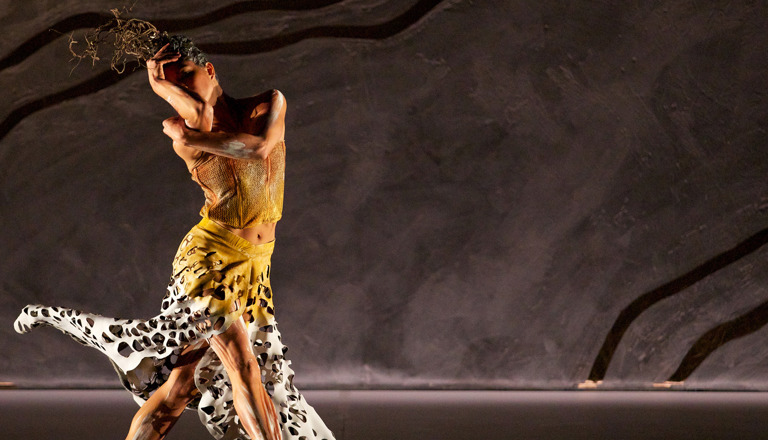Terrain (2012)
Bringing the Stories to the Stage: The Creative Process
RESEARCH AND PREPARATION
Prior to working with the dancers in the studio, Frances Rings (choreographer), Jacob Nash (set designer) and David Page (composer) travelled to Lake Eyre at a time when the lake was full of water. They spent time on country and also viewed Lake Eyre from the air. They experienced the ‘deafening silence’ of the vast and monumental landscape. Rings travelled again to the area when the lake was dry – when the colours, the wildlife and the climate are completely different to the wet conditions.
The artists were introduced to Arabunda elder Uncle Reginald Dodd, who led them onto his country and shared his knowledge about the land, the resources, and the reasons why it is so important to preserve the Lake region for future generations. They experienced the landforms, the colours, the air, the animal life – but most importantly the spiritual presence of ancestors and the stories that embed the land with cultural meaning. As cultural consultant for Terrain, Uncle Reg was critically important to the development and presentation of the work. He guided and supported the artists, making sure their interpretations reflected his own sense of responsibility to country.
In Rings’ words, “Being with Uncle Reg on his country and hearing his stories made me think deeply about Indigenous people like myself who live in urban areas and our relationship to country. I realised that although the location may be different the connection is the same. We have a profoundly visceral understanding of country that goes beyond brick walls, concrete and an urbanised lifestyle”.
The journey of discovery and the creative process involved in the making of Terrain are closely linked through the journey of emotional response and the processing of ideas.
DANCE PRACTICE
Terrain was created by the choreographer, in close collaboration with the dancers, the composer of the music, and the costume, set and lighting designers. The people who take on these roles form the creative team. The creative team collaborates closely during the entire creative process to enable the dance to reflect the overall focus of the choreographer’s ideas.
The choreographer, the rehearsal director and the dancers work together in the dance studio for many hours each day over several weeks to create the choreographic vernacular and motifs for Terrain. Together they invent movements that are inspired by the stories and the responses to being on country, developing their artistic interpretations to build dance sequences into a cohesive structure to the work.
DANCE SKILLS
Using their dance technique and performance skills, the dancers work to blend the movements and make them clear, and technically achievable, before eventually settling on a final version of the choreography.
The rehearsal director is present throughout this process in order to rehearse the dance, so that the key qualities and details of the choreography as set by the choreographer are retained and remembered. As the work moves closer to its premiere date, the rehearsal director works with the dancers for many hours to make sure they can perform the dance consistently at the highest standard possible. At this point in the process, the technical elements of the designers – costume, set, and lighting – start to be incorporated.
DANCE PRODUCTION PROCESSES
In the week of the premiere performance, the dancers, rehearsal director, creative team and production crew move from the Bangarra dance studios to the theatre where they spend many hours rigging the set, positioning and programming the lighting, checking the sound levels and making necessary adjustments to the choreography to fit the space of the stage. This is called the ‘bump in’ and the production crew is largely responsible for coordinating this stage of the process. There is much excitement during this bump in week because no one has actually seen the finished work. How the work looks in the theatre is always different to the way it looks in the studio.
There is often a media call on the day of the premiere where photographers take pictures of the dancers in dress rehearsal, and journalists conduct interviews with the creative team. On premiere night reviewers will attend to write about the work for their respective newspapers, websites and blogs. These reviews are usually published as soon as possible after the premiere.
THE LIFE OF A DANCE
During the lengthy process of creating a new Bangarra production, ideas will change and surprising shifts in the original plans will occur. This is the normal nature of the creative process, and probably one of the most exciting things about making a new work. Importantly, the elements that do not change are the traditional stories and original cultural elements, which always remain respected and intact. As the dance is performed over time, the story is passed from one dancer’s body to another as different dancers are taught the choreography.

